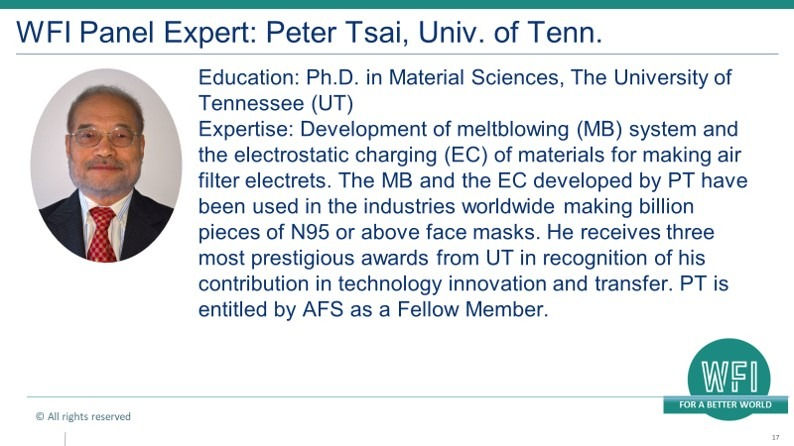Messages on Facemasks from Dr. Peter Tsai
- WFI

- Jun 7, 2020
- 2 min read

Meltblown (MB) microfiber fabrics after electrostatically charging are used as the filtering piece in medical masks and N95 respirators. Using this material, the required filtration efficiencies (FE) of bacteria, virus, and submicron particles are satisfactorily met mainly by the electrostatic attraction of the particles on the fiber surface by the charges embedded in the fibers at a low-pressure drop (DP) with high breathability across the mask. The masks are initially manufactured for a disposable one-time use. However, if there is a shortage, inactivation of the virus on the contaminated masks to reuse is possible. Several inactivation methods are discussed in this article in terms of their efficacy to kill the virus and the integrity of the mask in terms of loss of FE and the deformation of the respirators. In this paper, SARS CoV-2 and COVID-19 are used interchangeably.

Read the full research paper:
"I answered the autoclave question from the audience today based on the charge decay of PP at high temperatures. As I said, the charge decay by the treatment under hot air at 100C -120C, which is about the temperature of an autoclave, will not exceed 5% and it is still acceptable for an N95. This 5% is not calculated directly for FE or penetration but from the filtration index. My group did an experiment yesterday treating N95 at 100C for one hour. The penetration was increased from 0.39% to 0.607%. But the N95 shape was deformed so the leakage seal was altered. Different brands of N95, their outer and inner veils are composed of different materials which present different shape deformation and the seal leakage after heat treatment. Although the charges are still retained but the wearer needs to check the seal leakage. " -- Peter Tsai, 4/23/3020




Comments